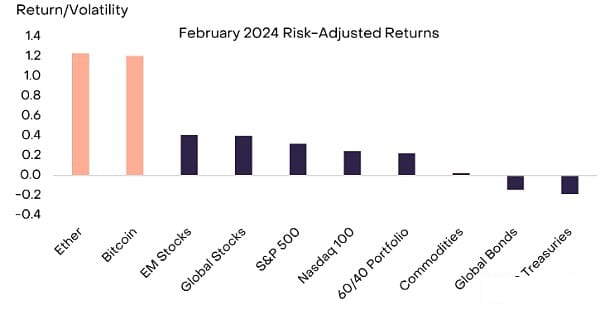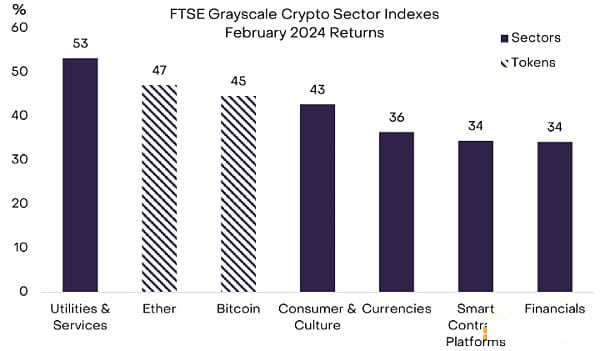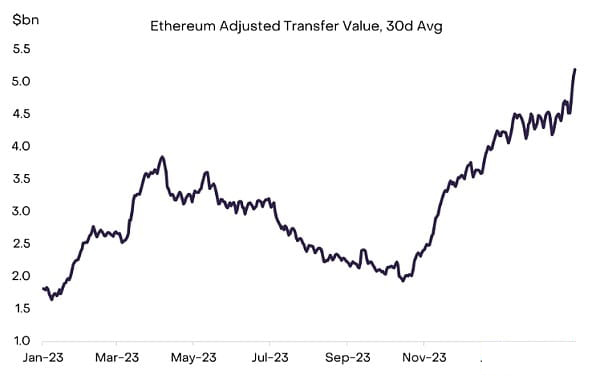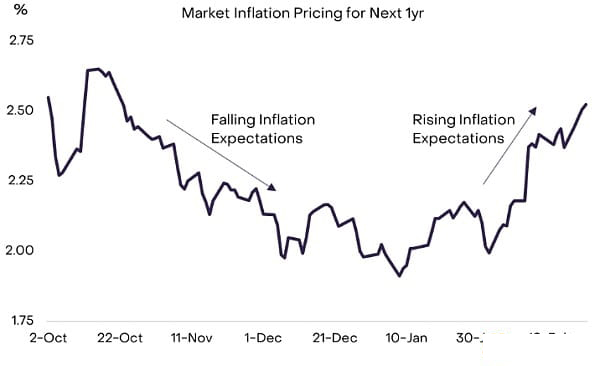Bitcoin prices rose 45% in February, surpassing $60,000 for the first time, and ended the month just 9% below its all-time high. This price increase may be influenced by large inflows into new U.S.-listed ETFs and expectations of the Bitcoin issuance halving in April. These factors have jointly promoted the upward momentum of Bitcoin prices, and the market's optimistic sentiment towards Bitcoin has also increased. Investors generally believe that Bitcoin's value potential has not yet been fully tapped, so it continues to attract capital inflows. The expectation of the halving of Bitcoin issuance has also caused a certain stir in the market, which is seen as a positive for Bitcoin supply
From the perspective of the crypto industry See, utilities and services play a dominant role in the crypto market. This area covers many projects, many of which may have synergies with artificial intelligence technology, such as Filecoin. The decentralized file storage service has expanded to cover computing capabilities and announced integration with Solana, further boosting the market. This trend shows that the crypto industry is constantly evolving and innovating, constantly seeking to integrate with other fields to achieve greater growth and development. The development of the crypto industry has moved beyond simple digital asset trading and towards a wider range of applications, setting the stage for future technological advancements. The main factors hindering valuation improvement. As inflation accelerated in February, doubts arose over whether the Federal Reserve would cut interest rates.
In February 2024, the performance of traditional asset markets was mixed, while the cryptocurrency market showed a solid growth trend. The situation was aided by inflows attracted by new physical Bitcoin exchange-traded funds (ETFs), as well as various positive fundamental developments. Currently, the main risk to the valuation of digital assets may be the Federal Reserve’s monetary policy: inflation rose again in February, and if it accelerates further, it may delay the timing of interest rate cuts, possibly until later this year or even longer.
Chart 1: Bitcoin and Ethereum outperformed many other major assets
For Bitcoin, solid returns may be at least partially reflective of The new U.S.-listed spot Bitcoin ETF has seen steady inflows. From their launch on January 11 to the end of that month, the ten spot Bitcoin ETFs saw net inflows totaling $1.46 billion. [1] In February, net inflows accelerated significantly, totaling $6 billion for the entire month. Across cryptocurrency exchange-traded products (ETPs), we estimate net inflows totaled $6.2 billion in February, more than double monthly records dating back to October 2021 (Chart 2). Notably, since the launch of the Bitcoin ETF, U.S.-listed gold ETFs have experienced net outflows, with investors switching from one “store of value” asset to another. [2] Chart 2: Net inflow record of cryptocurrency ETP
Chart 2: Net inflow record of cryptocurrency ETP
Although Bitcoin delivered solid returns in February, it was beaten by the second-largest crypto asset by market capitalization, Ethereum (ETH), which gained 47% during the month. [3] The market appears to be anticipating a major upgrade to the Ethereum network scheduled for March 13. Ethereum is pursuing a modular design philosophy, and over time, more activity will occur on the Layer 2 blockchain connected to the Layer 1 mainnet. The upcoming upgrade will accommodate this growth by providing Layer 2 with designated storage space on Ethereum, aiming to reduce its data costs and thereby increase its operating profits. Ethereum may also benefit from other tailwinds, including a focus on “re-staking” technology [4] — Eigenlayer, a leader in the space, raised $100 million from venture capital firm a16z this month [5] — and interest in ETH Denver Conference (February 29-March 3), and the prospects for regulatory approval of an ETH ETF.
The best-performing segment in February was utilities and services cryptocurrencies – up 53% (Chart 3). This product category includes tokens related to artificial intelligence (AI) technologies, some of which have seen huge gains. [6] Although not originally designed with artificial intelligence applications in mind, we expect Filecoin (FIL) to have benefited from market interest in this topic. The project initially focused on decentralized storage but now includes smart contracts and computing infrastructure, which could lead to synergies with blockchain-based artificial intelligence applications. On February 16, Filecoin announced an integration with Solana to provide a decentralized block history for the network. [7] Filecoin currently holds the dominant market share (approximately 99%) in decentralized data storage. [8]
Chart 3: Utilities and Services Crypto Industry Outperforms in Artificial Intelligence

The growth rate of the crypto-finance category is 34 %. [9] Part of the growth is due to the proliferation of governance tokens on the decentralized exchange (DEX) Uniswap. The platform generates revenue through transaction fees, a portion of which is transferred to the Uniswap Foundation when users visit the front-end website. However, no revenue currently flows directly to holders of the UNI governance token. On February 23, the Uniswap Foundation’s head of governance proposed distributing fee revenue directly to UNI holders who stake tokens and delegate voting rights on the platform. [10] If implemented, the UNI token would receive a portion of transaction fees from one of the largest decentralized finance applications by transaction volume.
The increase in valuations in February was accompanied by an increase in transaction volume and a rise in various on-chain metrics, especially Ethereum. For example, average daily ETH spot trading volume reached $5.8 billion in February, the highest level since September 2021, according to Coin Metrics data. The value of all transfers on the Ethereum network also increased to its highest level since June 2022 (Chart 4). Finally, the total stablecoin market capitalization increased by another $5.5 billion this month. [11] In related news, stablecoin issuer Circle announced that it will stop supporting USDC on the Tron blockchain. [12] About 80% of USDC in circulation is on the Ethereum network, and only about 1% is on Tron (of which Tether is the main stablecoin). [13]
Chart 4: Ethereum’s on-chain transfers continue to increase

On the back of Bitcoin ETF inflows and various fundamental positive factors , the cryptocurrency market has had a strong year. However, an important lesson from the last crypto cycle is that macro factors such as Federal Reserve monetary policy and economic conditions can significantly impact crypto asset valuations. If the macro market outlook remains positive, many aspects of the industry, including Bitcoin’s halving and Ethereum’s upgrade, could point to further gains in coin prices over the course of the year. Now, the price of Bitcoin is only 9% above its all-time high, so a new record may be reached later this year.
In contrast, a less favorable macro outlook may dampen valuations. In Q4 2023, Bitcoin may benefit from the Fed's move from tax rate reduction to tax rate cuts. If the central bank does cut interest rates in the coming months, it could weaken the dollar and support the valuations of assets that compete with the greenback, including Bitcoin. But during January (with February data reported), the steady decline in US inflation appeared to be slowing or stalling by some measures [14] and markets began to discount the outlook for higher inflation (Figure 5) . If inflation remains stubborn, Fed officials may consider lowering the delay to the second half of this year or until 2025. In general, higher U.S. interest rates[15] may be positive for the value of the U.S. dollar and may be negative for Bitcoin.
We believe that the most likely outcome is that U.S. consumer price inflation will continue to decline, prompting the Federal Reserve to eventually cut interest rates. But crypto investors should keep an eye on upcoming inflation reports (specifically the CPI report on March 12 and the PPI report on March 14) as well as updated policy rate guidance from the Federal Reserve at its next meeting on March 20.
Chart 5: Markets Price Higher U.S. Inflation

The above is the detailed content of Grayscale: Who is driving the crypto market's February surge?. For more information, please follow other related articles on the PHP Chinese website!




